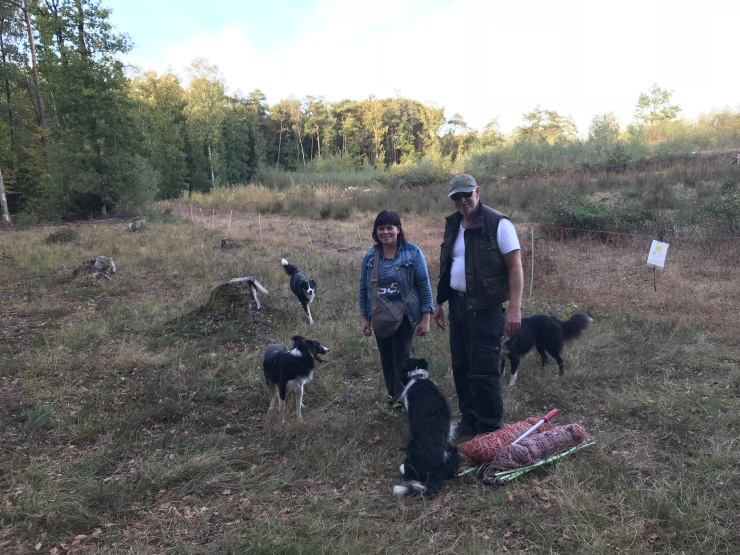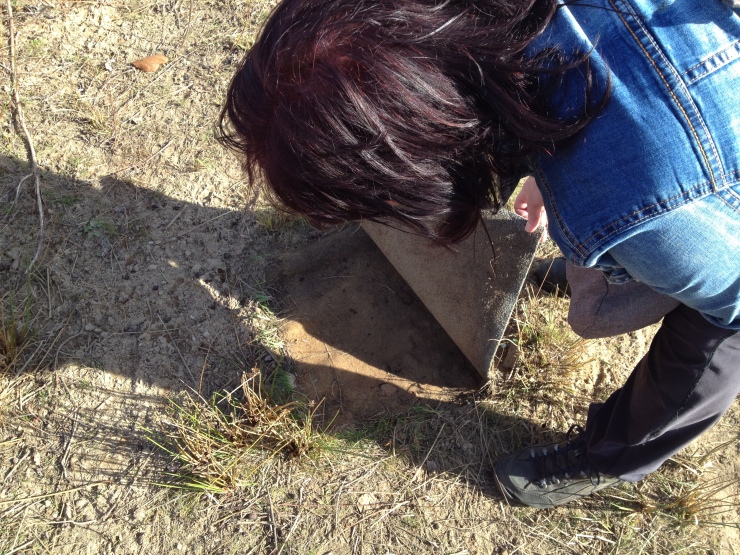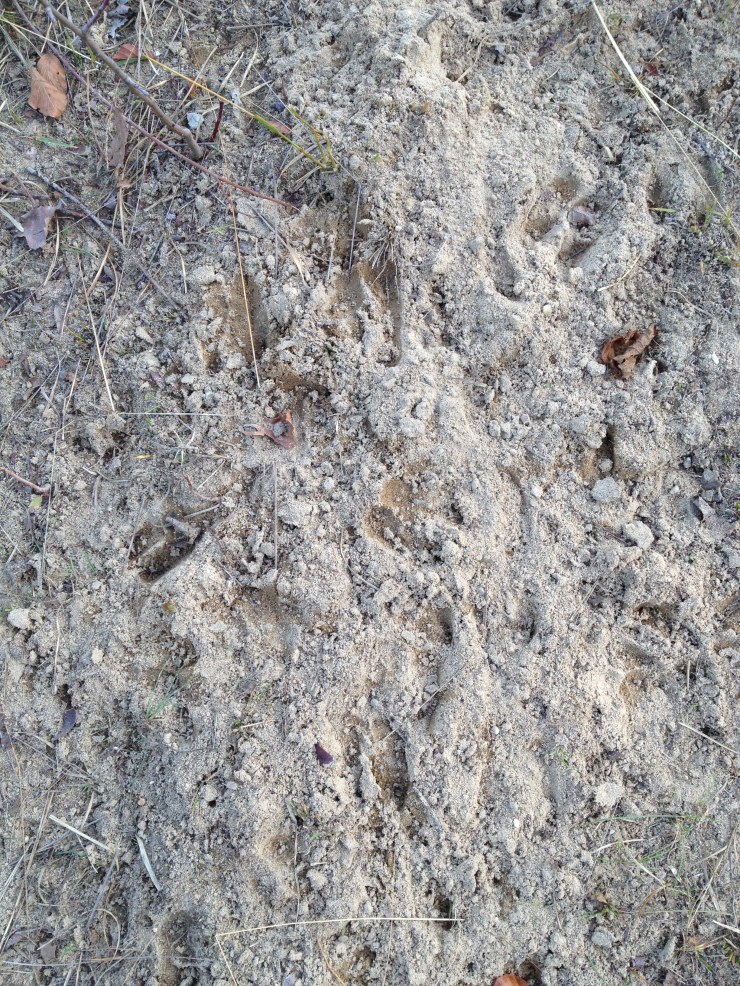A visit to two Dutch shepherds yesterday took me to another beautiful but very different landscape. Instead of large expanses of wide open farmland, as I had seen in Os, I biked through a forested area, with patches of sand dunes, and a 4 lane highway cutting it in half. This was the ‘Goois Natuurreservat Laapersbos’ and ecoduct in the Hilversum area.

A large nature reserve, this is where the ‘heide’ or heather is in abundance, but is being threatened by quickly spreading woods and other evasive bush and grass species. The heather grows on the dune area very well, keeping sand from blowing away. A carpet of it stops the sun getting through and seeds taking root from for example, evasive oak and pine trees.
 photo: Shepherds Ester and Werner Floor, their collies and sheep in behind.
photo: Shepherds Ester and Werner Floor, their collies and sheep in behind.
In what seems more of a test than a routine contract, shepherds Ester and Werner Floor have been granted a section of the this natural reserve for maintenance by their herd. Hopefully, they can convince parties involved in the maintenance of Holland’s natural parks to use more sheep for its maintenance, and contract directly to shepherds with small herds. The herd I was with consists of three dutch ‘heide’ sheep breeds: the horned Drentse, the white faced Hoge Veluwe, and the brown faced Kempisch. And what a sight to see: a beautiful woolly carpet, the same colour as the sand, moving over the land with 4 energetic border collies swirling about.


Ester and Werner finally filled in a blank for me regarding shepherdry in The Netherlands versus other countries such as Spain and France. Dutch shepherds are herders and grazers, and do not participate in transhumance. This is because the Dutch landscape is flat.
The weather effects the landscape rather evenly across the country. Sheep are not taken on long journeys for days on end, such as to higher greener pastures in the summer as is done in alpine areas. Most shepherds, like Ester and Werner, move their sheep around as grazers, sourcing the few jobs available to them from Provincial Landscape and Forestry Departments.

Bordering this nature reserve made up of ancient sand dunes are encroaching pine forests and bike paths, and splicing through its heart, the A27 highway and an ecoduct. As the Dutch like to do, the landscape is engineered to create and route nature. Although you wouldn’t know it in this particular spot, except for the blurry sound of a super highway, a 4 laner runs right through and under sections of this nature reserve. Ester and I were standing on top of the A27 on a open 20 meter wide expanse of sand and heather.

Like a Le Corbusier dream separating pedestrians and trees from car, this corridor is a safety passage for deer, fox, wild pig and sheep. A cross-provincial and national border system, this is part of a linked European nature system which has yet to be completely achieved. I suspect the costly logistics of maintenance, building and maintaining relations between various provinces and countries, and the nature of the beast, has made for impossible, and complex management skills. Although the Dutch love this kind of control, it may not translate as easily to other nations or to wandering animals.

 photos: on top of the highway: the ecoduct passage with high fences and walls for animals only.
photos: on top of the highway: the ecoduct passage with high fences and walls for animals only.
Where no primeval ‘wild’ nature exists in The Netherlands, controlling what they have made themselves is a Dutch ethos. What I learned from Ester is the management of areas like the ecoduct is long term, and it is vital to keep them clear of trees, high bushes or grasses so animals such as deer, have a wide view of where they are going, and a long sight line to detect lurking predators. Tunneling animals into a green passage compresses free-range movement, and although gives a better chance of not being killed by cars, dictates where an animal can or should go. I’m curious if these ecoducts are successful, whether animals use them or keep to either side, and if the dream to create space for animals is causing more harm than good if the system is not fluid. I have also heard that tunneling animals allows for predators to wait at each end, with open mouths.
 photo: a man made pool vital for animals with wall in behind with highway. The sheep keep the area around the pools clear for animal access
photo: a man made pool vital for animals with wall in behind with highway. The sheep keep the area around the pools clear for animal access
Maintaining nature in The Netherlands has been a mechanical dream, making new land sometimes from the sea, for trees, forest and agriculture. In this area, one of Ester and Werner’s competition are tractor machines which clear the land from evasive species very quickly, but also everything else in their way. Their wheels compress soil which creates desertification, and kill many small animals such as lizards, snails, worms, bird nests and eggs. Walking the ecoduct, Esther showed me plastic mats laid down to attract small creatures, but in some cases, ruined by clearing machinery.
 photo: Ester lifts the ‘easier option’ mat which attracts small animals like worms and beetles, but is often run over by tractors.
photo: Ester lifts the ‘easier option’ mat which attracts small animals like worms and beetles, but is often run over by tractors.
 photo: a beautifully designed fort for attracting and protecting smaller creatures from landscape maintenance tractors.
photo: a beautifully designed fort for attracting and protecting smaller creatures from landscape maintenance tractors.
The sheep of Ester and Werner are proving in this context that they do a far better job than one man on a large mower. The sheep selectively eat evasive plants such as black berry bushes, pitrus grass, pine seedlings and nettles whilst leaving the desired heather in place.
photo: the evasive pitrus or rush grass (left), and a bush made naked without its leaves by sheep nibbling. Without leaves the bush has less sources of energy and eventually dies.
No machine can compete with the selective hunger of their sheep. And in just two days, a large section of land, as pictured below, is mowed naturally, kept open from the encroaching oak and pine forest, whilst providing a variety of food for the sheep. In addition, their poop helps to create a healthier soil which pine trees don’t like.
 Another special attribute sheep bring to land maintenance is their hooves. As they tread gently over the sand, it is opened to air and sun for more heather to grow. Heather seeds are also distributed on the wool of the sheep, and when they drop, hooves push them into the ground without disturbing creatures or organisms in the soil.
Another special attribute sheep bring to land maintenance is their hooves. As they tread gently over the sand, it is opened to air and sun for more heather to grow. Heather seeds are also distributed on the wool of the sheep, and when they drop, hooves push them into the ground without disturbing creatures or organisms in the soil.

Because most sheep in The Netherlands are raised for their meat, they are kept on farms. The maintenance of nature reserves or parks is mostly done by man and machines. As described by Ester, when animal grazing is asked for, shepherd teams are contracted.
In discussion with Ester and Werner, the details shepherds see are vital to the sheep’s health and correct maintenance of the land. For example, as we were walking, Ester showed me grasses that must be eaten further down by sheep to reduce regrowth. When the sun is too hot, and there are no trees for shelter, Ester has put up a tent for her sheep. Also, sheep also eat, digest and sleep throughout a 24 hour schedule. It’s not just in the day that they eat and at night sleep. They will sleep for half an hour and get back at it. It’s part of a 4x digestion cycle. To hold them in an area overnight demands a thorough investigation before placing fencing up. The spot must have enough, and the right kind of food. A place must not have poisonous sources such as acorns. This takes the eye of a good shepherd.
photos: Ester and Werner prepare electric fencing for the evening sheep shelter. The electric fencing keeps sheep in an area with suitable food to eat. It also protects against dogs let loose by their owners. Dogs often scare and can attack the sheep. Unfortunately, public communication and awareness about sheep grazing and how to behave around sheep dogs is not anywhere close to that found in France. A lot of extra measures have to be taken by individual shepherds, such as talking with the public. The expensive electric box of the shepherds is often stolen, so the design is heavy duty. The battery and casing is very heavy, and its pole deeply secured into the ground. The yellow warning sign on the fencing flaps loosely on purpose, to scare deer away. The wolf is not yet in their area, but Ester and Werner are very fearful nonetheless.
From a regulatory perspective, shepherds find it difficult to deal with rules and regulations informed by managers rather than, and what used to be, researchers with practical experience and in regular contact with those practicing on the ground. Currently, veterinarian researchers are learning more from theory and books, than from practice, creating a next generation of managers looking down from far away to inform policy.
Some shepherds are organizing themselves into a guild. Through a collective effort, the guild will hopefully have more influence to press the Dutch government, and the 12 Nature ‘Departments’ which carve up The Netherlands, to hand funds directly to shepherds. It is also an opportunity to consider more grazing for the protection of landscapes, and the valourization of professions such as shepherding.









